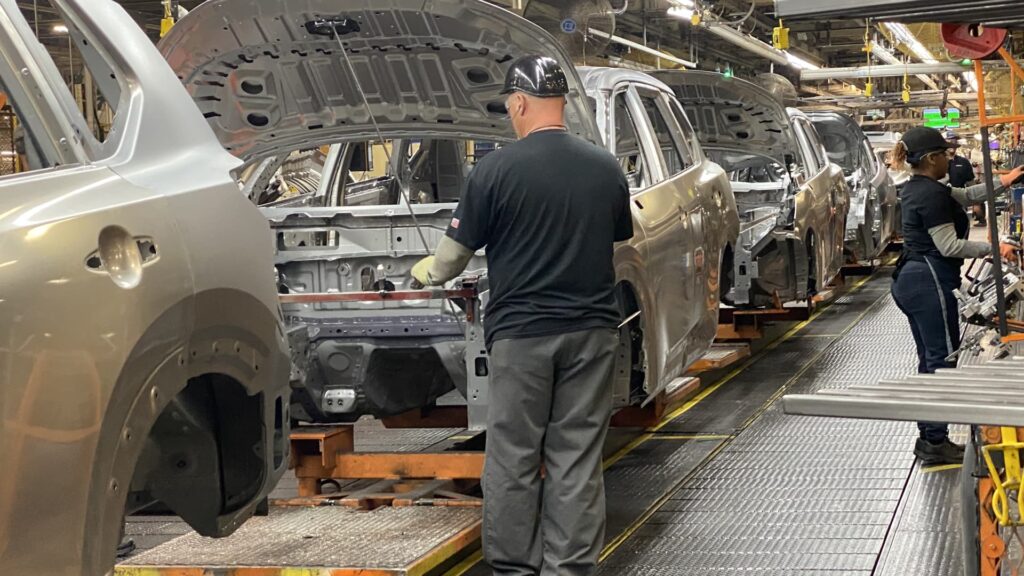
US Auto Tariffs Impact: Industry Faces $100 Billion Cost and Million-Vehicle Sales Drop
US Auto Tariffs Impact: Industry Faces $100 Billion Cost and Million-Vehicle Sales Drop
Autoworkers at Nissan’s Smyrna Vehicle Assembly Plant in Tennessee. The US auto tariffs impact is expected to affect both domestic and foreign manufacturers. Photo: Michael Wayland / CNBC
Table of Contents
US Auto Tariffs Impact: The Policy Shift
The US auto tariffs impact is beginning to materialize as President Donald Trump’s 25% levies on imported vehicles remain in effect, despite a recent pullback on other country-based tariffs. This significant policy shift is expected to create massive global implications for the automotive industry, affecting manufacturers, consumers, and the broader economy.
The US auto tariffs impact extends beyond the initial 25% tariff on imported vehicles implemented on April 3, 2025. Additional levies of the same magnitude on automotive parts are set to begin by May 3, creating a compounding effect that will ripple through the entire automotive supply chain.
Industry experts are characterizing the US auto tariffs impact as potentially transformative for the sector. “What we’re seeing now is a structural shift, driven by policy, that’s likely to be long-lasting,” Felix Stellmaszek, Boston Consulting Group’s global lead of automotive and mobility, told CNBC. “This may well be the most consequential year for the auto industry in history – not just because of immediate cost pressures, but because it’s forcing fundamental change in how and where the industry builds.”
Key Elements of the US Auto Tariffs Impact
- 25% tariff on imported vehicles effective since April 3, 2025
- Additional 25% tariff on automotive parts beginning May 3, 2025
- Expected industry-wide cost increase of $100+ billion
- Projected reduction in vehicle sales by upwards of 2 million units annually
- Anticipated price increases of $2,000-$6,000 per vehicle
- Potential restructuring of global automotive manufacturing and supply chains
Financial Impact on the Auto Industry
The financial dimensions of the US auto tariffs impact are staggering, with multiple industry analyses projecting costs in excess of $100 billion. Boston Consulting Group (BCG) estimates that tariffs will add between $110 billion and $160 billion on an annual run rate basis in costs to the industry, potentially impacting 20% of U.S. new-vehicle market revenues.
The US auto tariffs impact will be felt by both international and domestic manufacturers. The Center for Automotive Research (CAR), a Michigan-based nonprofit think tank, projects that costs for automakers in the U.S. alone will increase by $107.7 billion. This includes $41.9 billion in additional costs for Detroit automakers General Motors, Ford Motor, and Stellantis.
These figures encompass the comprehensive US auto tariffs impact including both the current 25% tariffs on imported vehicles and the forthcoming levies on automotive parts. The magnitude of these costs raises significant questions about how much manufacturers can absorb versus what will be passed on to consumers.
| Analysis Source | Projected Industry Cost | Key Components |
|---|---|---|
| Boston Consulting Group | $110-160 billion annually | Impact on 20% of U.S. new-vehicle market revenues |
| Center for Automotive Research | $107.7 billion for U.S. automakers | $41.9 billion for Detroit’s Big Three |
| Goldman Sachs | Low to mid single-digit thousand dollars per vehicle | Hard for industry to fully pass on to consumers |
| Cox Automotive | $3,600-6,000 price increase per vehicle | Varies based on import status and parts content |
Industry analysts are particularly concerned about the compounding US auto tariffs impact as costs cascade through global supply chains. Even domestically produced vehicles rely on imported components, creating complex cost calculations that vary by model and manufacturer.
Expected Price Increases for Consumers
A direct consequence of the US auto tariffs impact will be higher vehicle prices for consumers. Goldman Sachs analyst Mark Delaney noted in a Thursday investor report: “We believe the tariffs as proposed will raise the cost of both importing and manufacturing vehicles in the US by at least a low to mid single digit thousand dollar level on average, and we believe it will be hard for the auto industry to fully pass this on, especially with softening consumer demand more generally.”
The US auto tariffs impact on retail prices is expected to materialize over the next six to twelve months. Goldman Sachs projects that new vehicle net prices in the U.S. will rise by approximately $2,000 to $4,000 during this period to better reflect tariff costs. This represents a significant increase on top of already elevated vehicle prices, with Cox Automotive reporting that new vehicles currently cost nearly $50,000 on average.
Detailed Price Impact Projections
Cox Automotive estimates the US auto tariffs impact on specific vehicle categories:
- Imported vehicles: Approximately $6,000 increase due to the 25% tariff on foreign-assembled vehicles
- U.S.-assembled vehicles: Approximately $3,600 increase due to the upcoming 25% tariffs on automotive parts
- Additional increases: $300 to $500 from previously announced tariffs on steel and aluminum
The US auto tariffs impact on affordability is compounded by the current financing environment. Auto loan rates remain near decades-high levels, with current rates exceeding 9.64% for a new vehicle and nearly 15% for a used car or truck, according to Cox. These financing costs, combined with tariff-driven price increases, create a significant affordability challenge for consumers.
Sam Abuelsamid, vice president of insights at auto advisory firm Telemetry, expects a brief buffer period before the full US auto tariffs impact on prices manifests. He notes that many automakers likely have approximately a two-month supply of non-tariff impacted vehicles that they will sell through before implementing more substantial price increases due to the tariffs.
Vehicle Sales Projections Under New Tariffs
The US auto tariffs impact on vehicle sales is expected to be substantial, with multiple analyst firms projecting significant declines. Telemetry anticipates that higher costs for production, parts, and other factors will result in upwards of 2 million fewer vehicles sold annually in the United States and Canada.
This projected sales decline represents a major dimension of the US auto tariffs impact on the industry’s overall health. A reduction of 2 million units annually would represent approximately 12% of the U.S. auto market, which typically sells around 16-17 million new vehicles per year. Such a contraction would likely trigger production cuts, potential layoffs, and other cost-saving measures across the industry.
The ripple effects of this sales decline extend far beyond the automotive sector itself. “A couple million-unit reduction in sales will have a broad impact economically,” notes Abuelsamid. “That’s driven by higher prices, not just for vehicles, but across the board … which is going to limit people’s spending power.” This broader US auto tariffs impact on consumer purchasing power could affect retail, housing, and other major economic sectors.
Market Segment Vulnerability
The US auto tariffs impact will likely vary significantly by market segment, with certain categories facing more substantial challenges:
- Entry-level vehicles: Most vulnerable due to thinner profit margins and price-sensitive buyers
- Luxury imports: Facing the largest absolute price increases but serving customers with greater ability to absorb costs
- Electric vehicles: Particularly vulnerable due to already-challenged profitability and high component import content
- Pickup trucks: Better insulated due to higher domestic content and stronger profit margins
How Automakers Are Responding
Automakers have implemented varied strategies in response to the emerging US auto tariffs impact. Those with predominantly domestic manufacturing operations, such as Ford and Stellantis, have rolled out temporary incentive programs like employee pricing to maintain sales momentum while they adjust their longer-term strategies.
At the other end of the spectrum, some manufacturers with high import dependence have taken more dramatic actions in response to the US auto tariffs impact. British luxury carmaker Jaguar Land Rover has temporarily ceased U.S. shipments while it recalibrates its pricing and supply chain approach, highlighting the immediate disruption caused by the policy shift.
South Korean manufacturer Hyundai Motor has adopted a different approach to managing the US auto tariffs impact, announcing it would not raise prices for at least two months to ease consumer concerns. This strategy likely aims to maintain market share while the company adjusts its supply chain and potentially accelerates U.S. production plans at its facilities in Alabama and Georgia.
Cox Automotive Chief Economist Jonathan Smoke predicts a phased response to the US auto tariffs impact: “We expect to see declining discounting and then accelerated price increases as the tariffs are passed through and supply tightens, leading to price increases on all types of most new vehicles. Over the longer term, we expect production and sales to fall, newly used prices to increase, and some models to be eliminated.”
Potential Long-Term Manufacturer Strategies
As the US auto tariffs impact unfolds, automakers are likely to implement various strategic adjustments:
- Supply chain localization: Accelerating efforts to source more components from domestic or tariff-exempt suppliers
- Manufacturing rebalancing: Shifting production of U.S.-bound vehicles to North American plants
- Model rationalization: Discontinuing low-margin imported models that cannot absorb tariff costs
- Technology prioritization: Focusing R&D investments on high-margin features and capabilities
- Vertical integration: Bringing more component manufacturing in-house to control costs
Broader Economic Implications
The US auto tariffs impact extends far beyond the automotive industry itself, creating ripple effects throughout the broader economy. With automotive manufacturing representing approximately 3% of U.S. GDP and supporting millions of direct and indirect jobs, the sector’s health has significant macroeconomic implications.
Consumer sentiment data suggests the US auto tariffs impact is already contributing to economic anxiety. The University of Michigan’s closely watched consumer sentiment survey showed sentiment declining more than anticipated in April, with expected inflation reaching its highest level since 1981. Rising vehicle costs contribute to this inflation perception, potentially affecting consumer behavior across multiple spending categories.
The financing sector represents another dimension of the US auto tariffs impact. With auto loans accounting for a significant portion of consumer credit, price increases that push more buyers toward longer loan terms or higher interest financing could create additional stress in credit markets. The combination of higher vehicle prices and already-elevated interest rates may increase default risk in automotive lending.
Interconnected Economic Effects
The US auto tariffs impact creates a complex web of economic consequences:
- Reduced discretionary spending as consumers allocate more budget to vehicle purchases
- Potential job impacts in manufacturing, dealerships, and supporting industries
- Higher transportation costs affecting logistics and delivery services
- Reduced fleet purchases by businesses facing higher vehicle acquisition costs
- Secondary effects on used vehicle markets as demand shifts from new to used
- Potential trade retaliation affecting other U.S. export sectors
For industries adjacent to automotive, the US auto tariffs impact creates both challenges and opportunities. Automotive repair and aftermarket parts sectors may benefit from consumers keeping vehicles longer, while new car dealerships could face margin pressure and reduced sales volumes. Transportation network companies like Uber and Lyft may face higher vehicle acquisition costs for their drivers, potentially affecting service availability and pricing.
Long-Term Industry Transformation
Perhaps the most profound aspect of the US auto tariffs impact is its potential to accelerate structural transformation within the automotive industry. As BCG’s Stellmaszek noted, the tariffs are “forcing fundamental change in how and where the industry builds” vehicles, potentially reshaping global automotive manufacturing for decades to come.
The US auto tariffs impact could significantly alter investment patterns, with manufacturers accelerating plans to localize production in North America. This could benefit regions with established automotive manufacturing infrastructure while creating challenges for carmakers that have historically relied heavily on imported vehicles for the U.S. market.
Beyond geographical shifts, the US auto tariffs impact may influence product development strategies. Manufacturers might prioritize platforms and technologies that can be efficiently produced with North American supply chains, potentially affecting the pace of innovation in certain vehicle categories. This could be particularly consequential for electric vehicles, which currently rely heavily on imported components including batteries and electronics.
Strategic Questions for the Industry
The US auto tariffs impact raises fundamental strategic questions that automotive executives must address:
- How quickly can global supply chains be restructured to mitigate tariff impacts?
- Should manufacturers accelerate North American production investments despite uncertain policy longevity?
- How will changing cost structures affect competition between traditional and emerging automakers?
- Will consumers accept higher prices or shift to different vehicle categories and ownership models?
- How will these changes affect the industry’s transition toward electrification?
The comprehensive US auto tariffs impact represents what many analysts consider a pivotal moment for an industry already navigating multiple transformative forces including electrification, automation, and changing mobility patterns. As manufacturers adjust their strategies to this new reality, the resulting changes could reshape the automotive landscape for years to come, affecting everything from manufacturing employment to vehicle design and consumer ownership patterns.
As the industry adapts to these new conditions, the full US auto tariffs impact will likely unfold over multiple years, creating winners and losers among manufacturers based on their ability to adjust operations, manage costs, and maintain market relevance in an increasingly complex and policy-influenced global market.






